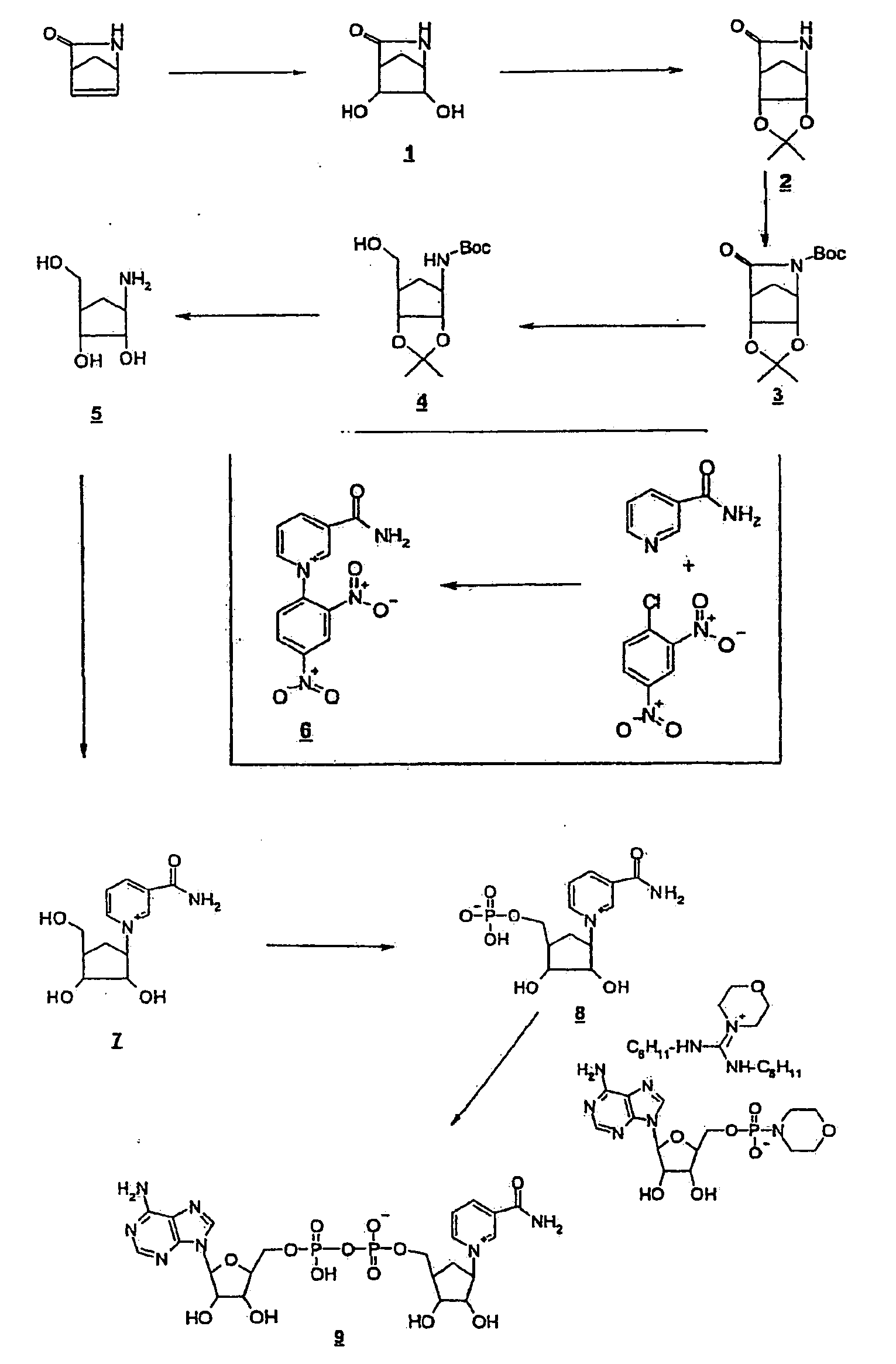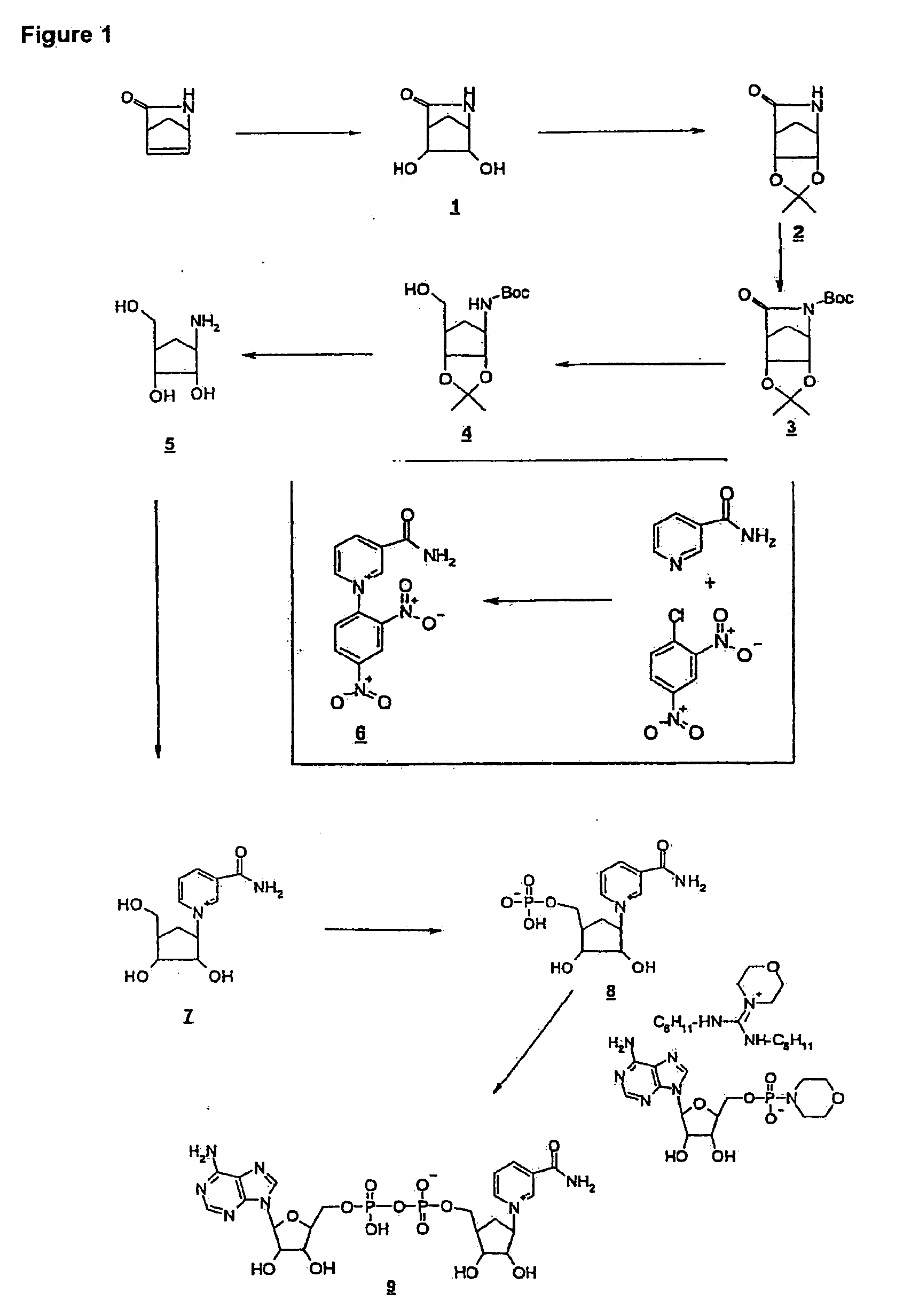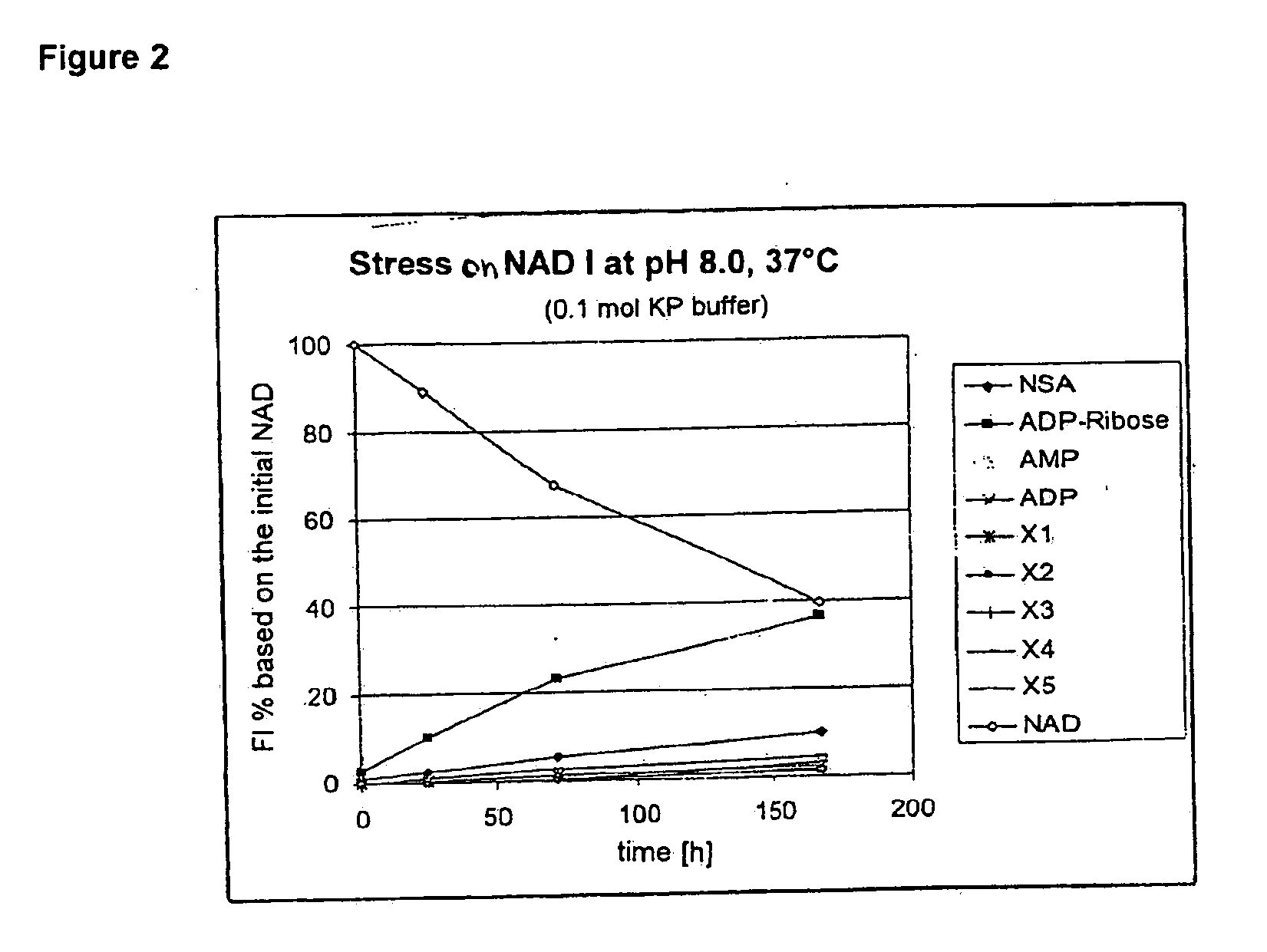[0050]they can be used in all previously known biochemical detection methods.
[0051]The disadvantages of the previously known biochemical, detection methods can be largely avoided by the provision of stable NAD / NADP derivatives using the present invention such as in combination with a stabilizing formulation such as for example by enclosing enzymes in
polymer networks. Moreover, it is not necessary to use stabilizing additives. This is particularly advantageous since the lower the number of reactive substances involved, the greater is the chance of obtaining a stable formulation for the
analyte determination.
[0052]Embodiments of the present invention provide test elements comprising a number of stable NAD / NADP derivatives which have aft adequate enzymatic activity for use as a coenzyme on the
test element.
[0053]Stable NAD / NADP derivatives can be produced in generally known processes of synthesis. For this the amino group of a cyclic amino
alcohol is converted into a
pyridinium derivative by Zincke
chemistry. The primary OH group is subsequently phosphorylated and coupled to an activated AMP derivative to form an NAD derivative. Alternatively the primary OH group can also be firstly phosphorylated and then the amino group can be converted into a
pyridine by means of the Zincke reaction.
[0055]Embodiments of the
test element according to the invention comprise for example compounds having the following general formula (I′):
[0058]U=in each case independently denotes OH, SH, BH3−; BCNH2−;
[0035]V=in each case independently denotes OH or a
phosphate group,
[0060]W ═COOR, CON(R)2, COR, CSN(R)2 in which R in each case independently denotes H or C1-C2-
alkyl,
[0037]X1, X2=in each case independently denote O, CH2, CHCH3, C(CH3)2, NH, NCH3,
[0060]W ═COOR, CON(R)2, COR, CSN(R)2 in which R in each case independently denotes H or C1-C2-
alkyl,
[0077]Z=a saturated or unsaturated carbocyclic or heterocyclic five-membered ring, in particular compounds of the general formula (II)
if a
single bond is present between R5′ and R5″, then[0066]R5′═O, S, NH, NC1-C2-
alkyl, CR42, CHOH, CHOCH3,
[0040]where R4=in each case independently denotes H, F, Cl, CH3,
if a
single bond is present between R5′ and R5″, then[0066]R5′═O, S, NH, NC1-C2-alkyl, CR42, CHOH, CHOCH3,
if a
single bond is present between R5′ and R5″, then[0066]R5′═O, S, NH, NC1-C2-alkyl, CR42, CHOH, CHOCH3,
if a single bond is present between R5′ and R5″, then[0066]R5′═O, S, NH, NC1-C2-alkyl, CR42, CHOH, CHOCH3,
if a single bond is present between R5′ and R5″, then[0066]R5′═O, S, NH, NC1-C2-alkyl, CR42, CHOH, CHOCH3,
in which a single or
double bond can be present between R5′ and R5″,[0064]R4=in each case independently denotes H, F, Cl, CH3,
[0022]FIGS. 6A and 6B show absorption spectra of NAD and pNAD.
[0069]Compounds of the following general formula (I″) are another
subject matter of the invention:
[0058]U=in each case independently denotes OH, SH, BH3−; BCNH2−;
[0035]V=in each case independently denotes OH or a phosphate group,
[0060]W ═COOR, CON(R)2, COR, CSN(R)2 in which R in each case independently denotes H or C1-C2-alkyl,
[0037]X1, X2=in each case independently denote O, CH2, CHCH3, C(CH3)2, NH, NCH3,
[0060]W ═COOR, CON(R)2, COR, CSN(R)2 in which R in each case independently denotes H or C1-C2-alkyl,
[0077]Z=a saturated or unsaturated carbocyclic or heterocyclic five-membered ring, in particular compounds of the general formula (II)
if a single bond is present between R5′ and R5″, then[0066]R5′═O, S, NH, NC1-C2-alkyl, CR42, CHOH, CHOCH3,
[0040]where R4=in each case independently denotes H, F, Cl, CH3,
if a single bond is present between R5′ and R5″, then[0066]R5′═O, S, NH, NC1-C2-alkyl, CR42, CHOH, CHOCH3,
if a single bond is present between R5′ and R5″, then[0066]R5′═O, S, NH, NC1-C2-alkyl, CR42, CHOH, CHOCH3,
if a single bond is present between R5′ and R5″, then[0066]R5′═O, S, NH, NC1-C2-alkyl, CR42, CHOH, CHOCH3,
if a single bond is present between R5′ and R5″, then[0066]R5′═O, S, NH, NC1-C2-alkyl, CR42, CHOH, CHOCH3,
in which a single or
double bond can be present between R5′ and R5″,[0064]R4=in each case independently denotes H, F, Cl, CH3,
[0022]FIGS. 6A and 6B show absorption spectra of NAD and pNAD.
provided, that if R5═CH2, T═O, U=in each case denotes OH, V═OH, W═CONH2, X═O and Y═O then R5′ and R5″ are not simultaneously CHOH,
[0083]In a preferred embodiment the compounds according to the invention contain adenine analogues such as C8-substituted and N6-substituted adenine, deaza variants such as 7-deaza aza variants such as 8-aza or combinations such as 7-deaza or 8-aza or carbocyclic analogues such as formycin where the 7-deaza variants can be substituted in the 7 position with
halogen, C1-C6-alkinyl C1-C6-alkenyl or C1-C6-alkyl.
[0084]In a further embodiment the compounds contain
adenosine analogues which contain for example 2-methoxydeoxyribose, 2′-fluorodeoxy-
ribose, hexitol, altritol or polycyclic analogues such as bicyclic, LNA and
tricyclic sugars instead of ribose.
[0085]In particular (di)phosphate oxygens can also be isoelectronically substituted such as for example O− by S− and / or by BH3−, O by NH, NCH3 and / or by CH2 and ═O by ═S.
[0086]In one embodiment at least one residue U of the compound according to the invention is different from OH and in other embodiments at least one residue U═BH3−.
[0087]Yet other embodiments are the derivatives borano carbaNAD, c-pentyl NAD, pyrrolyl NAD, furanyl NAD, carbaNADcyclophosphate, carbaNADP, pyrrolidinyl NAD as well as test elements which contain them:
[0088]Biochemical detections of analytes, for example parameters in body fluids such as blood, serum,
plasma or
urine or in samples of waste water of foods are of major importance in diagnostics. In these tests the
analyte to be determined is brought into contact with a suitable enzyme and a coenzyme provided on a
test element.
[0089]Hence, another
subject matter of the present invention is an enzyme-coenzyme complex comprising a compound according to the invention in combination with a suitable enzyme.
[0090]Any biological or chemical substances that can be detected by a
redox reaction can be determined as analytes e.g. substances which are substrates of a coenzyme-dependent enzyme or the coenzyme-dependent enzymes themselves. Examples of analytes are glucose,
lactic acid,
malic acid,
glycerol,
alcohol,
cholesterol, triglycerides,
ascorbic acid,
cysteine,
glutathione, peptides,
urea,
ammonium, salicylate, pyruvate, 5′-
nucleotidase,
creatine kinase (CK),
lactate dehydrogenase (LDH),
carbon dioxide etc.
[0091]For the detection of enzyme substrates, embodiments of a test element may contain an enzyme that is suitable for detecting the substrate, in addition to the coenzyme. Suitable enzymes are for example dehydrogenases selected from
glucose dehydrogenase (E.C.1.1.1.47),
lactate dehydrogenase (E.C.1.1.1.27, 1.1.1.28),
malate dehydrogenase (E.C.1.1.1.37),
glycerol dehydrogenase (E.C.1.1,1.6),
alcohol dehydrogenase(E.C.1.1.1.1), alpha-
hydroxybutyrate dehydrogenase,
sorbitol dehydrogenase, and
amino acid dehydrogenase e.g. L-
amino acid dehydrogenase (E.C.1.4.1.5). Further suitable enzymes are oxidases such as
glucose oxidase (E.C.1.1.3.4) or
cholesterol oxidase (E.C.1.1.3.6) or aminotransferases such as aspartate or
alanine aminotransferase, 5′-
nucleotidase or
creatine kinase.
[0092]For the detection of enzymes, embodiments of a test element may contain an enzyme substrate suitable for detecting the enzyme, in addition to the coenzyme.
[0093]Another aspect of the present invention is the use of a compound according to the invention or of an enzyme-coenzyme complex according to the invention to detect an
analyte in a sample by an enzymatic reaction. In this connection the detection of glucose with the aid of
glucose dehydrogenase (GlucDH) is an exemplary use.
[0094]The change in the
coenzyme i.e. in the compound according to the invention by reaction with the analyte (if the analyte is an enzyme substrate) or by an analyte-catalysed reaction (if the analyte is an enzyme) can in principle be detected in any desired manner. Basically all methods for detecting enzymatic reactions that are known from the prior art can be used. For example, the change in the coenzyme can be detected by optical methods. Optical detection methods for example include the measurement of absorption,
fluorescence,
circular dichroism (CD), optical rotary dispersion (ORD),
refractometry etc.
Fluorescence measurement in particular is
highly sensitive and enables the detection even of low concentrations of the analyte in miniaturized systems.
[0095]A liquid test can be used to detect an analyte in which the
reagent is for example present in the form of a solution or suspension in an aqueous or non-aqueous liquid or it is present as a
powder or lyophilisate. It is, however, also possible to use a dry test, in which case the reagent is applied to a carrier, such as a test strip. The carrier can for example be a test strip comprising an absorbent or / and swellable material that is wetted by the sample liquid to be examined.
[0096]A
gel matrix in which an enzyme-coenzyme complex is incorporated can, however, also be used as a detection reagent (cf. DE 102 218 45 A1).
[0097]In this case the enzyme can either be polymerized into the matrix together with the compound, according to the invention or, after the
polymerization, the matrix can be contacted with a solution of the coenzyme in the presence of the enzyme to form the corresponding enzyme-coenzyme complex.
[0098]Another aspect of the present invention concerns a reagent kit and its use to detect analytes. The reagent kit can contain a compound according to the invention, a suitable enzyme and a suitable reaction buffer. Suitable enzymes have already been described. The reagent kit according to the invention can be used in a wide variety of ways and can be used to determined analytes such as glucose,
lactic acid,
malic acid,
glycerol, alcohol,
cholesterol triglycerides,
ascorbic acid,
cysteine,
glutathione, peptides,
urea,
ammonium, salicylate, pyruvate, 5′-
nucleotidase, CK, LDH and
carbon dioxide etc. In one embodiment, a reagent kit is provided which contains a compound according to the invention and
glucose dehydrogenase (E.C.1.1.1.47) to detect glucose in blood.
[0088]Biochemical detections of analytes, for example parameters in body fluids such as blood, serum,
plasma or
urine or in samples of waste water of foods are of major importance in diagnostics. In these tests the analyte to be determined is brought into contact with a suitable enzyme and a coenzyme provided on a test element.
[0100]Another aspect of the present invention concerns a test strip for the fluorometric or photometric detection of an analyte. Such a test strip contains a compound as stated above as a coenzyme and a suitable enzyme or an enzyme substrate immobilized on an absorbent or / and swellable material. Suitable materials can for example be selected from
cellulose, plastics etc.
[0101]Another aspect of the present invention comprises a method for detecting an analyte comprising the steps:
[0102](a) contacting a sample with a test element or reagent kit according to the invention comprising a coenzyme; and
[0103](b) detecting the analyte e.g. on the basis of a change in the coenzyme.
[0104]One aspect of the invention is that the
fluorescence emission of the coenzymes exhibits a
bathochromic shift and hence there is low interference with the
fluorescence emission of other materials of the test element or / and of the sample.
[0105]All embodiments of the aspects of the present invention that are described and / or shown are also intended to apply to other aspects of the invention such as, e.g., embodiments of the compounds according to the invention.
 Login to View More
Login to View More 


